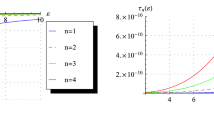Abstract
We theoretically investigate the coherent time of a single qubit in a RbCl quantum well (QW) with asymmetric Gaussian confinement potential (AGCP) using the Pekar-type variational method. Additionally, we utilize Fermi’s golden rule to consider strong coupling between electrons and longitudinal optical phonons in the QW with an electric field applied. The results show that the coherence time changes with AGCP QW’s height, height of the QW, polaron radius and electric field. Moreover, we also show that the coherence time is minimized to \( \tau = 412.0\;{\text{ps}} \) in a confinement potential range \( R = 0.19\;{\text{nm}} \). Thus we conclude that these tunable parameters of the QW are vital for adjusting the coherence time and deciding the stability of the qubit.




Similar content being viewed by others
References
I.A. Akimov, T. Godde, K.V. Kavokin et al., Phys. Rev. B 95, 155303 (2017)
M.A. Yeranosyan, A.L. Vartanian, K.A. Vardanyan, Phys. E 75, 330 (2016)
C. Faugeras, M. Orlita, S. Deutchlander et al., Phys. Rev. B 80, 073303 (2009)
J.C. Abadillo-Uriel, M.J. Calderón, Phys. Lett. A 372, 7081 (2008)
X. Chen, O. Keller, Phys. Rev. B 55, 15706 (1997)
A. Hernández-Cabrera, P. Aceituno, F.T. Vasko, Phys. Rev. B 67, 045304 (2003)
J. Jung, O. Keller, Phys. Rev. A 98, 053825 (2018)
Y. Sun, X.J. Miao, Z.H. Ding et al., J. Semicond. 38, 042002 (2017)
J.L. Xiao, Int. J. Theor. Phys. 55, 147 (2016)
C.Y. Cai, C.L. Zhao, J.L. Xiao, Commun. Theor. Phys. 63, 159 (2015)
W. Xiao, B. Qi, J.L. Xiao, J. Low Temp. Phys. 179, 166 (2015)
J.L. Xiao, Int. J. Theor. Phys. 55, 147 (2015)
L.D. Landau, S.I. Pekar, Zh. Eksp. Teor. Fiz. 16, 341 (1946)
S.I. Pekar, M.F. Deigen, Zh. Eksp. Teor. Fiz. 18, 481 (1948)
S.I. Pekar, Untersuchungen über die Elektronen-theorie der Kristalle (Akademie Verlag, Berlin, 1954)
T.D. Lee, F.E. Low, D. Pines, Phys. Rev. 90, 297 (1953)
A.J. Fotue, M.F.C. Fobasso, S.C. Kenfack, Eur. Phys. J. Plus 131, 205 (2016)
Z.W. Wang, J.L. Xiao, Acta Phys. Sin. 56, 241 (2007)
X.J. Ma, J.L. Xiao, Opt. Quant. Electron. 50, 144 (2018)
L.D. Landau, E.M. Lifshitz, Quantum Mechanics (Nonrelativistic Theory) (Pergamon Press, London, 1987)
J.L. Xiao, Superlatt. Microstruct. 90, 308 (2016)
J.T. Devreese, Polarons in Ionic Crystals and Polar Semiconductors (North-Holland Publ. Co., Amsterdam, 1972)
B. Hackens, S. Faniel, C. Gustin, X. Wallart, S. Bollaert, A. Cappy, V. Bayot, Phys. Rev. Lett. 94, 146802 (2005)
J. Hackmann, P. Glasenapp, A. Greilich, M. Bayer, F.B. Anders, Phys. Rev. Lett. 115, 207401 (2015)
X.Z. Yuan, K.D. Zhu, W.S. Li, Eur. Phys. J. D 31, 499 (2004)
J. Wiersig, Phys. Status Solidi B 248, 883 (2011)
Acknowledgements
The subject is supported by Natural Science Foundation of China (No. 11464033) and Natural Science Foundation of Inner Mongolia Autonomous Region of China under Grant No. 2017MS (LH) 0107
Author information
Authors and Affiliations
Corresponding author
Appendix
Appendix
Acorrding to trial ground and first excited state wavefunctions of electron and phonon system (polaron)
we can calculate the ground and first-exited energies of polaron. Form (A1) and (A2), we also choose trial ground and first excited state wavefunctions of electron \( \left| 0 \right\rangle = \pi^{{ - \frac{{3}}{4}}} \lambda_{0}^{{\frac{{3}}{2}}} \exp \left[ { - \frac{{\lambda_{0}^{2} r^{2} }}{2}} \right] \) and \( \left| 1 \right\rangle = \left( {\frac{{\pi^{3} }}{4}} \right)^{{ - \frac{{1}}{4}}} \lambda_{1}^{{\frac{{5}}{2}}} r\cos \theta \exp \left( { - \frac{{\lambda_{1}^{2} r^{2} }}{2}} \right)\exp \left( { \pm i\phi } \right) \) with \( \left\langle 0 \right.\left| 0 \right\rangle = 1 \), \( \left\langle 1 \right.\left| 1 \right\rangle = 1 \), \( \left\langle 0 \right.\left| 1 \right\rangle = 0 \).
For a QW with AGCP, these energies can be expressed as:
Therefore, the energy-level separation is written as
Appling Eqs. (A1), (A2) and (A5), we can obtain the coherence time.
Based on the electric dipole approximation and FGR [21], the coherence time can be expressed by the spontaneous emission rate [22]
We can now expand the \( e^{{ - i\varvec{k} \cdot \varvec{r}}} \approx 1 - i\varvec{k} \cdot \varvec{r} + \ldots \) term to allow us to compute matrix element more easily. Since the \( \varvec{k} \cdot \varvec{r} \approx \frac{\alpha }{2} \) and the matrix element is squared, our expansion will be in powers of \( \alpha^{2} \) which is a small number. The dominant decays will be those form the zearth order approximation which is \( e^{{ - i\varvec{k} \cdot \varvec{r}}} \approx 1 \).
Due to the Hamiltonian and \( \varvec{r} \) in satisfying relationship of \( \left[ {H,\varvec{r}} \right] = \frac{\hbar }{i}\frac{\varvec{p}}{m} \), we can write \( \varvec{p} = \frac{im}{\hbar }\left[ {H,\varvec{r}} \right] \) in terms of the commutator.
Thus, the spontaneous emission rate is expressed as
Here, we put the \( \left| 0 \right\rangle \) and \( \left| 1 \right\rangle \) into \( \left| {\left\langle 0 \right|\varvec{r}\left| 1 \right\rangle } \right|^{2} . \)
We first operate the
Substitute formula (A10) into formula (A9), (A9) is changed as
We put formula (A12) into formula (A9)
Rights and permissions
About this article
Cite this article
Sun, Y., Xiao, JL. Qubit coherence effects in a RbCl quantum well with asymmetric Gaussian confinement potential and applied electric field. Eur. Phys. J. Plus 135, 592 (2020). https://doi.org/10.1140/epjp/s13360-020-00604-4
Received:
Accepted:
Published:
DOI: https://doi.org/10.1140/epjp/s13360-020-00604-4




